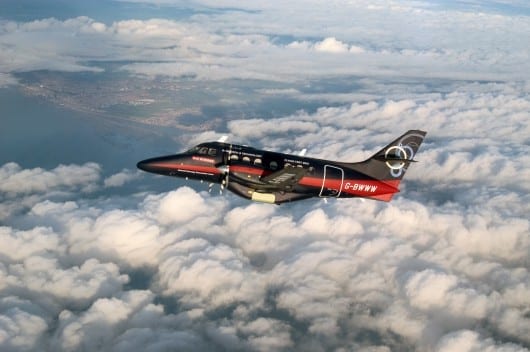
It may be that the Top Gun of the 21st century is an artificial intelligence.
In April of this year, a BAE Systems Jetstream research aircraft flew from Preston in Lancashire, England, to Inverness, Scotland and back. This 500-mile (805 km) journey wouldn’t be worth noting if it weren’t for the small detail that its pilot was not on board, but sitting on the ground in Warton, Lancashire and that the plane did most of the flying itself. Even this alteration of a standard commercial prop plane into an Unmanned Aerial Vehicle (UAV) seems a back page item until you realize that this may herald the biggest revolution in civil aviation since Wilbur Wright won the coin toss at Kitty Hawk in 1903.
The Jetstream flight was conducted as part of the Autonomous Systems Technology Related Airborne Evaluation & Assessment (ASTRAEA) program, which is a UK industry-led consortium aimed at developing unmanned aircraft that can operate routinely in civilian airspace. It’s one of hundreds of UAV projects around the world, but what’s notable about it is how the use of a passenger plane blurs the line between quadcopter-with-a-camera jobs and full-blown airliners.
For many people, UAVs came out nowhere. In the popular imagination, they started out as exotic reconnaissance aircraft in the early days of the Afghanistan War that have grown in numbers and sophistication until they’ve turned into experimental combat aircraft taking off from aircraft carriers. In fact, UAVs have come from a number of areas aside from the military. Hobbyists have made their contributions, scientists as well, and, of course, aircraft engineers.
In many ways, UAVs are a bit like computers. First they were rare and then they were everywhere. Whether they’re tiny quadcopters that fly within a few hundred feet of their operator or huge winged affairs piloted via satellite thousands of miles from the joystick, UAVs are taking to the skies in ever-increasing numbers for a a variety of applications.
One obvious area for UAVs to move into is police work. Take away the missiles and hunting for bad guys on a civilian street is very similar to hunting them on the battlefield. The challenges are virtually the same and transferring the technology from one sphere to the other is relatively straightforward. An eye in the sky could be used for general law enforcement, border control, sea lane monitoring, traffic control, crime scene photography, searching for missing persons, and combating drug trafficking.
The FBI has admitted in recent congressional testimony to using UAVs in the US on a number of occasions and some US police departments have been granted permission by the FAA to operate them. In Canada, a UAV is credited with saving a man’s life. However, other locations, such as Seattle, have abandoned plans for their own drones due to the fierce debate over the use of UAVs in law enforcement.
The question isn’t just whether drones should be used at all, but also how they should be used. Should they only be used in extraordinary circumstances, such as hostage situations? Should they be used routinely like a CCTV camera on a pole a hundred feet tall? What sort of oversight is needed? How can privacy issues be addressed? When does policing go over the line to surveillance of the public?
The Latest Bing News on:
The future of unmanned flight
- Air Force making gains in artificial intelligence with AI-piloted F-16 flighton May 4, 2024 at 4:04 pm
The Air Force successfully gamed a dogfight between a normal F-16 and AI-controlled F-16, with the head of the Air Force riding in the front seat.
- Air Force secretary gets taste of future of aviation combat in AI-piloted crafton May 4, 2024 at 1:25 pm
An AI-piloted experimental fighter gave Secretary of the Air Force Frank Kendall a glimpse of the future during a relatively low-speed demonstration flight this week.
- An AI-controlled fighter jet took the Air Force leader for a historic ride. What that means for waron May 3, 2024 at 5:41 pm
AI marks one of the biggest advances in military aviation since the introduction of stealth in the early 1990s, and the Air Force has aggressively leaned in. Even though the technology is not fully ...
- An AI-powered fighter jet took the Air Force's leader for a historic ride. What that means for waron May 3, 2024 at 5:04 am
The flight on the Artificial Intelligence-controlled modified F-16, is serving as a public statement of confidence in the future role of AI in air combat. The military is planning to use the ...
- Army heads into competitive flight demos for future tactical droneon April 25, 2024 at 7:24 pm
The Army has awarded contracts to two companies to continue on in a competition to provide a Future Tactical Unmanned Aircraft System.
- Opinion: The future of war is unmanned and underwateron March 15, 2024 at 9:07 am
Yet the threat from China is near-term, not merely a future challenge. This necessitates an immediate combat capacity increase and the importance of a distributed, unmanned underwater vehicle ...
- The Sustainable Future of Flighton December 4, 2023 at 7:23 am
So it may seem surprising to find both ambitious and practical plans for delivering a more sustainable future at a global ... airlines for a single day Flight has the power to connect people ...
- The drone wranglers: How the most authentic Old West town in the US is delivering the future of flighton December 22, 2022 at 4:59 pm
Airport engineer Wayne Green designed and built 16 unmanned vehicle ... 10 years in the future. "The hope is it's a hub for UAS, where we've got users out here doing flight testing.
- Unmanned solar plane smashes recordson July 16, 2010 at 5:00 am
London, England (CNN)-- An unmanned solar aircraft has smashed the world record for continuous flight. The "Zephyr" plane, developed by UK defense technology company, QinetiQ, took off from the U ...
The Latest Google Headlines on:
The future of unmanned flight
[google_news title=”” keyword=”the future of unmanned flight” num_posts=”10″ blurb_length=”0″ show_thumb=”left”]
The Latest Bing News on:
Unmanned aerial vehicle
- Boeing's Breakthrough Manned-Unmanned Aerial Refueling Enhances Naval Operationson May 7, 2024 at 5:55 am
"An F/A-18F Super Hornet performs an arrested landing ...
- Türkiye ramps up border security with unmanned ground vehicleson May 6, 2024 at 1:26 am
Amid illegal immigration and terrorism threats, Türkiye turns to unmanned ground vehicles along its lengthy borders ...
- Expanding Skies: The Ascendant Market of Unmanned Aerial Vehicleson May 5, 2024 at 11:06 pm
The landscape of modern warfare and commercial enterprises is rapidly transforming with the ascent of Unmanned Aerial Vehicles (UAVs), commonly known as drones. The UAV market, a once-niche sector ...
- Indigenous bomber unmanned aircraft developed by Bengaluru firm unveiledon May 4, 2024 at 9:39 am
Flying Wedge Defence, a city based defence and aerospace technology firm on Friday unveiled the FWD-200B unmanned aircraft.
- PERSPECTIVE: Violent Non-State Actors Use of Armed Unmanned Aerial Vehicles (UAVs): Latest Useson April 30, 2024 at 5:00 pm
Unmanned Aerial Vehicles (UAVs) have featured prominently in the ongoing war between Russia and Ukraine, proving that small UAVs can not only support intelligence, surveillance and target acquisition, ...
- Udhampur: Anti-terror operation enters day 3, forces deploy unmanned aerial vehicle to track terroristson April 30, 2024 at 2:06 am
Security forces are using an unmanned aerial vehicle to track down the terrorists, who are hiding, taking cover of thick vegetation.
- Managing Aerial Video: Best Practices for Unlocking Drone Data Potentialon April 27, 2024 at 4:12 pm
Police departments nationwide are increasingly adopting unmanned aerial vehicles (UAVs), commonly known as drones, to enhance their operational and response capabilities. Providing enhanced ...
- 'Illicit' UAV sales to Iran: Three Indian firms among over dozen sanctioned by USon April 26, 2024 at 12:58 am
The US Department of Treasury said these companies, individuals and vessels have played a central role in facilitating and financing the clandestine sale of Iranian unmanned aerial vehicles (UAVs ...
- Global Unmanned Aerial Vehicle (UAV) Market Eyes US$ 106.03 Billion by 2030on April 25, 2024 at 4:17 pm
The Global Unmanned Aerial Vehicle (UAV) market is projected to offer a revenue opportunity of US$ 46.7 billion during the forecast period 2022-2030. The global UAV market is estimated to reach a ...
- Here are 4 ways to defend against unmanned ground vehicleson April 25, 2024 at 11:28 am
Global militaries are increasingly building, deploying, and operating unmanned ground vehicles, or UGVs. Mykhalio Fedorov, Ukraine’s Vice Prime Minister for Innovations, wrote on Twitter that, “I ...
The Latest Google Headlines on:
Unmanned aerial vehicle
[google_news title=”” keyword=”Unmanned aerial vehicle” num_posts=”10″ blurb_length=”0″ show_thumb=”left”]










